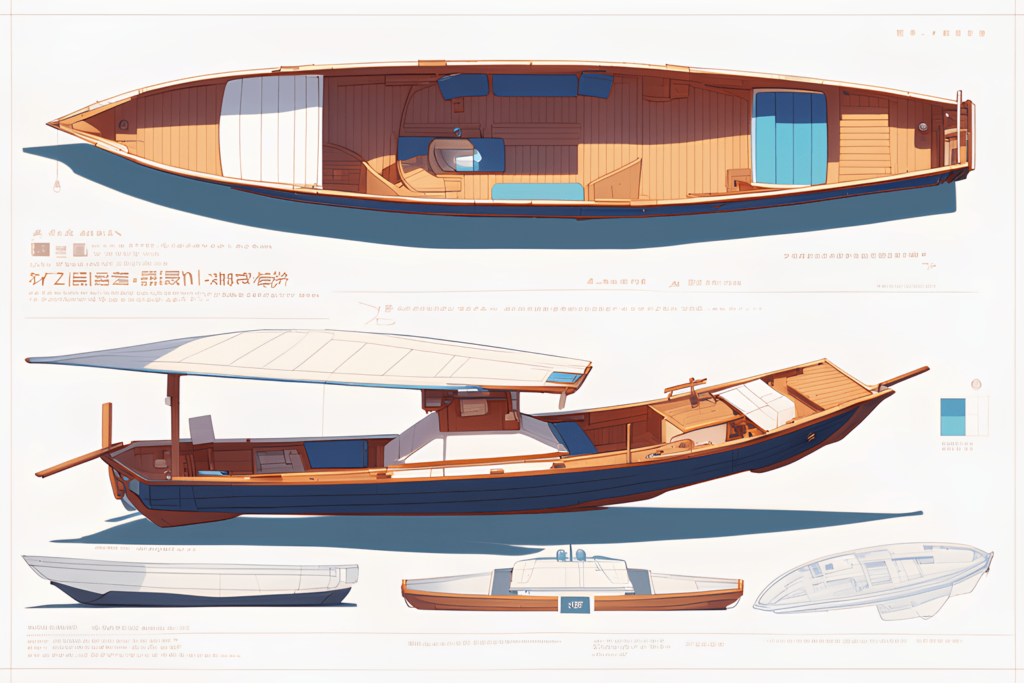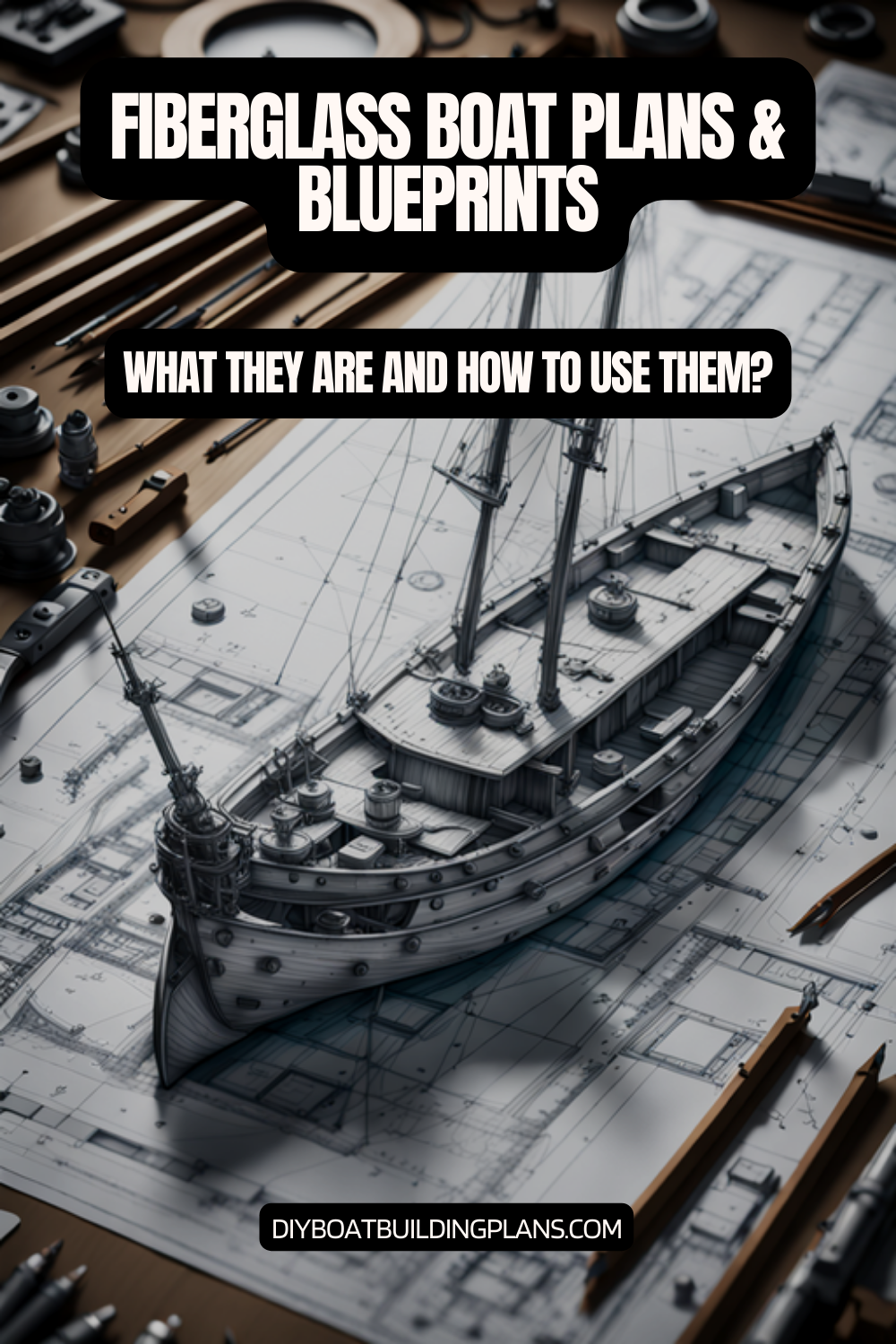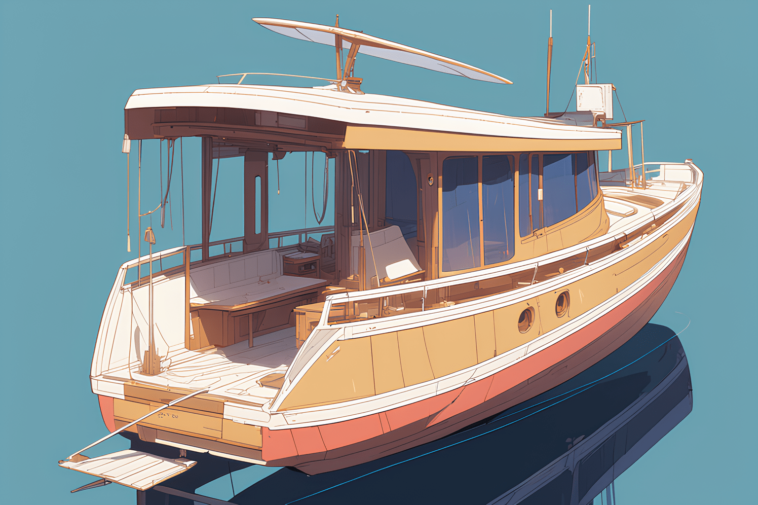Ever thought about turning your boating dreams into reality? Building your own fiberglass boat is more than just a dream. It’s a goal for DIY lovers. The journey from blueprint to boat is exciting.
Glen-L Marine offers a wide range of boat plans for all skill levels and tastes. You can choose from small 21-foot boats to big 106-foot ones. These plans open up a world of possibilities for boat lovers.
Fiberglass construction has changed boat building. It brings durability, lightness, and customization options that old methods can’t offer. Whether you want a fishing boat, a fast racer, or a cozy trawler, the right plans can make it happen.
Key Takeaways – Fiberglass Boat Plans & Blueprints
- Explore diverse boat designs from 21 to 106 feet
- Choose from multiple hull types and construction materials
- Customize boats for fishing, leisure, or professional use
- Access full-size frame patterns for precise building
- Select from power, sailing, and specialized boat versions

Introduction to DIY Fiberglass Boats
Diving into DIY boating opens a world of marine engineering and shipbuilding. Fiberglass boats are a great chance for enthusiasts to build their own boats. They can do it with precision and creativity.
Understanding the Basics of Fiberglass
Fiberglass has changed boat building. It’s lightweight but very strong. It’s perfect for amateur boat builders because of its many benefits:
- Exceptional durability
- Resistance to water damage
- Low maintenance
- Many design options
Advantages of Building Your Own Boat
Building your own boat is rewarding. It takes a lot of work, but it’s worth it. Here are some benefits:
- You can customize your boat fully
- It’s cheaper than buying one
- You’ll feel a great sense of achievement
- You’ll learn a lot about marine engineering
“Building your own boat is not just a project, it’s a transformation of passion into reality.”
Common Misconceptions Regarding Fiberglass
Many people think building a fiberglass boat is hard. But, with the right planning and patience, anyone can do it.
| Misconception | Reality |
|---|---|
| Fiberglass is too complicated | Accessible with right guidance and practice |
| Materials are extremely expensive | Can be affordable with careful planning |
| Only experts can build boats | Beginners can succeed with proper resources |
There are over 500 boat plans to download. You can choose from many construction methods. This makes it easy for anyone to start their marine engineering journey.
Choosing the Right Plans and Blueprints
Finding the perfect boat design blueprints is key to a successful DIY boat-building project. With over 500 plans to choose from, picking the right one is important. It requires careful thought and a strategic approach.
Understanding what makes a good boat plan is essential. The right blueprint can turn your dream of building a boat into reality.
What to Look for in Quality Plans
- Comprehensive detail and accuracy of measurements
- Clear step-by-step instructions
- Skill level compatibility
- Material specifications
- Support documentation
Popular Templates for DIY Fiberglass Boats
Some boat building plans are more popular among DIY enthusiasts:
| Boat Type | Complexity | Recommended Skill Level |
|---|---|---|
| Fishing Skiff | Low | Beginner |
| Coastal Cruiser | Medium | Intermediate |
| Performance Sailboat | High | Advanced |
Comparing Free vs. Paid Plans
Your budget and project needs will help you choose. Free plans might seem appealing, but paid blueprints offer:
- More detailed instructions
- Professional design quality
- Technical support
- Guaranteed accuracy
“The right boat plan is your blueprint for success” – Professional Boat Builder
Investing in quality boat design blueprints can save you time and money. It’s worth it for a successful DIY boat-building project.
Unlock the secrets to building your dream boat with MyBoatPlans! With detailed plans for over 518 boats and expert video tutorials, you’ll have everything you need to create your perfect vessel. Click here to begin your journey!”
Essential Tools and Materials
Starting a DIY fiberglass boat project needs careful planning and the right tools. Knowing the key tools and materials is vital for a successful build.
Critical Tools for Boat Building
Boatbuilders need a wide range of tools to make their dreams real. The most vital tools include:
- Measuring and layout tools (squares, levels, compasses)
- Cutting instruments (Japanese crosscut saws, jig saws)
- Sanding equipment (random orbital sanders)
- Precision hand tools (chisels, planes, spoke shaves)
- Fastening devices (drills, screwdrivers)
“Quality tools are the foundation of exceptional boat construction” – Professional Boat Builder
Recommended Fiberglass Materials
| Material Type | Recommended Specifications | Usage |
|---|---|---|
| Foam Core | 9mm, 80kg/cu.m density | Structural support |
| E-glass Fabric | 9oz weight | Reinforcement layer |
| Resin | Polyester or Epoxy | Binding and sealing |
Essential Safety Gear for DIY Projects
When working with fiberglass, safety is a top priority. Always wear:
- Chemical-resistant gloves
- Safety glasses
- Respirator mask
- Protective clothing
Investing in quality tools and understanding their use greatly improves your boat-building journey. Careful preparation and attention to detail are essential for a successful DIY fiberglass boat.
Step-by-Step Construction Process
Building a DIY fiberglass boat needs careful planning and precise steps. The process turns raw materials into a ready-to-use vessel. It requires patience, skill, and attention to detail.
Preparing the Workspace
Having a clean workspace is key for DIY Fiberglass Boat Plans & Blueprints. Choose a spot that’s clean, well-ventilated, and big enough for your project. Important steps include:
- Setting up a dust-free environment
- Organizing tools and materials
- Ensuring proper lighting
- Installing protective floor coverings
Framing Your Boat
Framing lays the foundation of your boat. Use your DIY Fiberglass Boat Plans & Blueprints for accurate measurements. For an 11.5-foot boat, you’ll need:
- 5 primary panels
- 3 structural frames
- 1 transom panel
“Precision in framing determines the ultimate strength and performance of your boat.”
Adding the Fiberglass Layers
Fiberglass construction needs careful layering. You’ll need about 8 yards of 6oz bidirectional fiberglass cloth. The steps are:
- Applying polyester or epoxy resin
- Carefully laying fiberglass cloth
- Rolling out air bubbles
- Ensuring uniform coverage
Finishing Touches and Detailing
The final stage makes your boat look and feel great. Invest time in careful finishing to boost durability and looks. This includes adding rubrails, smoothing surfaces, and applying protective coatings.
Building your boat takes 60-90 hours, with costs around $300-$500. Your hard work will pay off with a custom fiberglass boat.
Types of Fiberglass Boats to Build
DIY boating fans can choose from many boat designs. Fiberglass boats offer a wide range of projects for all skill levels. You can build anything from small fishing boats to big yachts.
Choosing the right boat depends on your skills, what you plan to use it for, and what you like. Each design comes with its own set of challenges and rewards.
Small Fishing Boats
Small fishing boats are great for beginners. They are usually 8 to 16 feet long. They have several benefits:
- Lower material costs
- Easier construction process
- More manageable workspace requirements
- Quicker completion time
Sailboats and Yachts
Sailboats and yachts are for those who want a bigger challenge. They need advanced skills and a bigger budget.
| Boat Type | Size Range | Complexity Level |
|---|---|---|
| Small Sailboat | 15-25 feet | Intermediate |
| Coastal Yacht | 30-40 feet | Advanced |
Personal Watercraft
Personal watercraft are a fun DIY option. They can be made for different activities, like fishing or just for fun.
“The joy of building your own boat is not just in the destination, but in the journey of creation.” – Anonymous Boat Builder
When picking a boat design, think about your skills, budget, and what you plan to use it for. Every project is a chance to make something special.
Cost Breakdown for DIY Projects
DIY boating fans often ask about the cost to build their dream boat. Knowing the costs is key for anyone thinking about a fiberglass boat project.
Building a boat needs careful budgeting. The cost of boatyard supplies can greatly affect your budget. Let’s look at the main costs for your DIY boating project.
Estimating Material Costs
Material costs are the biggest part of your budget. Here’s a detailed look at what you might spend:
- Fiberglass cloth: $300 – $800
- Resin and gelcoat: $500 – $1,200
- Core materials (foam): $1,000 – $1,600
- Hardware and additional components: $1,000 – $2,000
Budgeting for Tools and Equipment
Investing in the right tools is essential for a successful DIY boating project. You’ll likely spend:
| Tool Category | Estimated Cost |
|---|---|
| Basic Hand Tools | $200 – $500 |
| Specialized Boat Building Tools | $500 – $1,500 |
| Safety Equipment | $100 – $300 |
Long-Term Maintenance Expenses
DIY boating isn’t just about building. Ongoing maintenance is a big financial factor. Plan for:
- Annual inspection and repair: $300 – $800
- Protective coatings and sealants: $150 – $400
- Replacement parts: $200 – $500
“The joy of building your own boat is priceless, but smart financial planning makes the journey smoother.” – Experienced Boat Builder
Your total cost can be from $3,000 to $8,000. This depends on the boat’s size, complexity, and materials. Though it’s a big investment, the joy of making your own boat is worth it.
Tips for Successful Boat Building
Building a boat takes patience, skill, and planning. DIY boating fans can make their dreams come true. They just need to follow some key strategies and avoid common mistakes.
Time Management Strategies
Building a boat needs careful planning of time. New builders should:
- Start with smaller projects to build confidence
- Create a realistic project timeline
- Set aside dedicated work hours each week
- Break big tasks into smaller steps
“Planning is the blueprint of success in amateur shipbuilding.”
Common Mistakes to Avoid
DIY boating projects can be tough. Be careful of these common errors:
- Rushing through important construction steps
- Not preparing materials properly
- Ignoring safety checks
- Thinking you have more skills than you do
| Mistake | Potential Consequence | Prevention Strategy |
|---|---|---|
| Improper Resin Application | Weak Boat Structure | Use marine-grade epoxy, follow precise mixing instructions |
| Inadequate Fiber Layup | Structural Weakness | Practice lamination techniques before main project |
| Poor Tool Maintenance | Inaccurate Measurements | Regular tool calibration and cleaning |
Seeking Help from the Community
DIY boating fans get a lot from community support. Networking with experienced builders can provide invaluable insights. Consider:
Download over 500 Boat Plans. Click on the link below.
-->Click Here<--
- Joining online boat-building forums
- Attending local workshops
- Connecting with sailing clubs
- Participating in amateur shipbuilding groups
Remember, every expert was once a beginner. Keep trying, learning, and passionate about boat building.
Maintenance and Repairs for Fiberglass Boats
Keeping your fiberglass boat in top shape needs regular care and knowing its special needs. Guides for watercraft hobbyists stress the value of checking it often and taking care of it early. This helps your boat last longer and run better.
Starting with the right care means understanding your boat’s make-up. Most fiberglass boats use polyester resin and E-glass fibers. These materials make the boat strong and durable.
Routine Maintenance Checklist
- Inspect hull and deck for cracks or damage quarterly
- Clean and wax exterior surfaces every 3-4 months
- Check and lubricate moving parts
- Examine electrical systems and connections
- Verify structural integrity of core materials
Repairing Common Issues
Fixing fiberglass damage quickly is key to stopping it from getting worse. Important steps include:
- Identifying crack types and extent
- Preparing surfaces for repair
- Using appropriate epoxy systems
- Applying fiberglass cloth and resin
- Sanding and finishing repairs
Upgrading and Modifying Your Boat
Fiberglass boats are great for making changes. Think about adding:
- Cabin space and comfort
- Storage solutions
- Performance features
- Safety equipment
“Regular maintenance is the key to preserving your boat’s value and ensuring safe, enjoyable experiences on the water.” – Marine Maintenance Expert
The 15th Edition of the Fiberglass Boat Repair & Maintenance manual is a detailed guide. It covers everything from basic care to complex repairs.
Legal Considerations and Regulations
When you dive into marine engineering and DIY boating, you must follow many rules. Boat builders need to know the laws about building, registering, and using boats.
Before you launch your boat, you need to think about a few important legal points:
Understanding Boat Registration
Every DIY boat project must follow local and federal rules for registration. The rules vary by state and region for owning and using boats.
- Get the right hull identification number (HIN)
- Fill out state-specific registration forms
- Pay the needed registration fees
- Show the registration numbers correctly
Safety Requirements to Follow
Marine engineering means following strict safety rules. Your DIY boat must meet key safety standards to be legal and safe for passengers.
| Safety Requirement | Details |
|---|---|
| Personal Flotation Devices | Needed for all riders |
| Fire Extinguisher | Right class and amount |
| Navigation Lights | Installed and working right |
| Sound-producing Device | Horn or whistle for signals |
Environmental Regulations
Responsible DIY boating means knowing how to protect the environment. Choose materials and building methods that are good for nature.
“Responsible boat building is not just about craftsmanship, but also environmental stewardship.” – Marine Engineering Expert
Look up local laws, talk to maritime authorities, and keep up with legal needs. This will help you have a smooth and legal DIY boating journey.
Real-Life Success Stories
Amateur shipbuilding is more than a hobby. It shows human creativity and passion. DIY boating fans turn raw materials into beautiful boats. Their hard work and skill are inspiring.
Inspiring Builder Profiles
Scott Hershey’s story is truly amazing. He built a 16′ powerboat named “Lucille” in two years. His work shows great craftsmanship.
He used fiberglass and a 4-cycle 60 HP Mercury motor. He also made the boat comfortable and added special touches like a mahogany toerail.
Lessons from Experienced Builders
DIY boating needs patience, precision, and passion. Builders like Hershey see it as both art and science. They learn a lot about materials, techniques, and solving problems.
“The joy of building your own boat is not just in the finished product, but in the journey of creation.” – Scott Hershey
Key Insights from Successful Projects
Experienced builders share important tips for success:
- Invest in quality materials
- Understand boat design principles
- Be ready to adapt and modify plans
- Learn from each construction stage
These stories show that with determination and planning, anyone can make their DIY boating dreams come true.
Resources for Further Learning
Starting a DIY boat building project means always learning more. It’s important to have good guides for watercraft hobbyists. Boat builders can find many resources to improve their skills and knowledge.
Recommended Books and Guides
Looking for top-notch boat repair manuals and design tips? Here are some great books:
- Understanding Boat Design by Ted Brewer – A must-read for beginners
- Skene’s Elements of Yacht Design by Francis Kinney – Great for yacht design details
- The Nature of Boats by Dave Gerr – Insights on hull shapes and propellers
Online Communities and Forums
Online platforms are full of valuable connections for boat hobbyists:
- Boat building forums
- Social media groups for DIY boat projects
- Professional design websites with communities
“Knowledge shared is knowledge multiplied” – A core principle in boat building communities
Workshops and Training Programs
Professional training can really boost your boat building skills. Look into:
- Local maritime training centers
- Online certification programs
- Hands-on workshops with boat designers
Keep learning to become a skilled boat builder. Use quality resources and talk to experienced pros to get better.

Conclusion
Building your own fiberglass boat is more than a hobby. It’s an adventure that mixes technical skill, creativity, and passion. The DIY world of Fiberglass Boat Plans & Blueprints lets you turn raw materials into a personal watercraft. It shows off your unique vision and craftsmanship.
Amateur shipbuilding has changed a lot, thanks to new technologies like CAD software. These tools and special construction methods make building boats easier than before. Each project is a personal challenge that needs patience, dedication, and a desire to learn.
Fiberglass is three times stronger than wood, making your boat durable. This means your hard work will pay off with a strong vessel. It can handle tough marine environments.
Your boat-building journey is about more than just making a watercraft. It’s about connecting with a long tradition of maritime craftsmanship. Whether you dream of a small fishing boat or a complex yacht, the skills you gain are unmatched. The joy of sailing in a boat you built yourself is unmatched.
With the right plans, tools, and passion, anyone can make their boat-building dreams come true. So, get ready to start your DIY boat-building adventure. The waters are waiting, and your unique vessel is ready to be born.
FAQ – Fiberglass Boat Plans & Blueprints
What are the best fiberglass boat designs for beginners?
For beginners, start with small designs like the Glen-L Feather or the 8ft Dixi Dinghy. These are easy to handle and build. Glen-L offers plans from $15 to $5,965, fitting all skill levels and budgets.
How much does it cost to build a DIY fiberglass boat?
Costs vary by boat size and design. Materials like foam, fabric, and resin can cost from a few hundred to thousands of dollars. A small dinghy might cost $500-$1,000, while a large yacht can be over $10,000.
What materials do I need to build a fiberglass boat?
You’ll need foam, fabric, and resin. Tools like a hot-glue gun and safety gear are also necessary. The exact materials depend on your boat’s design and size.
Is fiberglass boat building suitable for complete beginners?
Yes, it’s challenging but doable for beginners. Start with simple designs and take online courses. Join communities and practice to improve. Resources like dixdesign.com and forums offer great help.
How long does it take to build a fiberglass boat?
Time varies with boat size and your skill. A small dinghy might take 100-200 hours, while a large yacht can take 1,000-2,000 hours. Your design, time, and skill level affect the build time.
What are the advantages of fiberglass boat construction?
Fiberglass is durable, low maintenance, and flexible in design. It’s resistant to rot and can be repaired easily. It’s great for all kinds of boats, from small dinghies to large yachts.
Are there any legal considerations for DIY boat building?
Yes, you must follow local boat registration and safety laws. Some designs may have special legal needs, like for charter work. Always check local maritime laws and safety standards before starting.
What maintenance is required for a fiberglass boat?
Regular checks for cracks and delamination are key. Repainting and hull protection are also important. Annual inspections and repairs can help your boat last longer.



